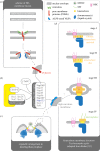Exotic mitotic mechanisms
- PMID: 23271831
- PMCID: PMC3603444
- DOI: 10.1098/rsob.120140
Exotic mitotic mechanisms
Abstract
The emergence of eukaryotes around two billion years ago provided new challenges for the chromosome segregation machineries: the physical separation of multiple large and linear chromosomes from the microtubule-organizing centres by the nuclear envelope. In this review, we set out the diverse solutions that eukaryotic cells use to solve this problem, and show how stepping away from 'mainstream' mitosis can teach us much about the mechanisms and mechanics that can drive chromosome segregation. We discuss the evidence for a close functional and physical relationship between membranes, nuclear pores and kinetochores in generating the forces necessary for chromosome segregation during mitosis.
Figures



References
-
- Gerdes K, Howard M, Szardenings F. 2010. Pushing and pulling in prokaryotic DNA segregation. Cell 141, 927–94210.1016/j.cell.2010.05.033 (doi:10.1016/j.cell.2010.05.033) - DOI - DOI - PubMed
-
- Schumacher MA. 2012. Bacterial plasmid partition machinery: a minimalist approach to survival. Curr. Opin. Struct. Biol. 22, 72–7910.1016/j.sbi.2011.11.001 (doi:10.1016/j.sbi.2011.11.001) - DOI - DOI - PMC - PubMed
-
- Salje J, Gayathri P, Löwe J. 2010. The ParMRC system: molecular mechanisms of plasmid segregation by actin-like filaments. Nat. Rev. Microbiol. 8, 683–69210.1038/nrmicro2425 (doi:10.1038/nrmicro2425) - DOI - DOI - PubMed
-
- Aylett CHS, et al. 2010. Filament structure of bacterial tubulin homologue TubZ. Proc. Natl Acad. Sci. USA. 107, 19 766–19 77110.1073/pnas.1010176107 (doi:10.1073/pnas.1010176107) - DOI - DOI - PMC - PubMed
-
- Jensen MR, Løbner-Olesen A, Rasmussen KV. 1990. Escherichia coli minichromosomes: random segregation and absence of copy number control. J. Mol. Biol. 215, 257–26510.1016/S0022-2836(05)80344-4 (doi:10.1016/S0022-2836(05)80344-4) - DOI - DOI - PubMed
Publication types
MeSH terms
Substances
Grants and funding
LinkOut - more resources
Full Text Sources
